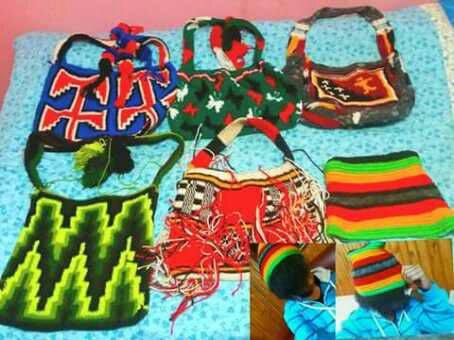by PETER S. KINJAP
IN PNG traditional society bilums were cultural expressions from each cultural village, made and used for specific purposes and occasions. Today bilums are common in many regions of the country and abroad.
Maureen Anne Mackenzie on her paper "Androgynous Objects: String Bags and Gender in Central New Guinea (1991)" related that bilums were made mostly by non-Austronesian speakers, that is, mostly the Highlands and Momase regions which today popular bilum designs and patterns emerge from Mendi, Mt. Hagen, Goroka, Madang and Wasara (Sepik).
The Austronesian language speaking people from Southern and New Guinea Island regions then made and used baskets and clay pot that serves the same purposes as the bilums.
With the influence of western ideas and promotions of their concepts, changes have scattered and displaced many traditional skills and knowledges. For PNG women, it did not altered their bilum making skills and knowledge but instead the changes affected the use and perception of bilums. The creation of transportation systems, communications and business inventions have inspired the women to curve those perceptions of changes through the twisting of ropes.
From commercial point of view, bilum offered an opportunity for cash generations. The emergence of large scale transforms bilum production leads to the adaption of modernization of the country. New forms of bilums with new different styles and patterns have appeared and have become successful in urban areas. To meet the new expectations and demand, bilum weavers have chosen new materials and modified techniques in the fabrication of bilum bags.
The choice of new materials could be attributed to scarcity and unavailability of the traditional bush materials. The process of making a bilum requires time and patience, and those mothers who intend to make few bucks invest to buy "wool" (arcylic) or Nylon in order to get income more quickly. Importantly, bilum weavers buy imported ropes maybe because of the prestige associated with imported goods.
Many bilum users carry bilums made of wool or Nylon consider that these modern materials are suitable to a modern environment. The use of imported materials allows women a level of complexity in pattern configuration which cannot be reached with fibres dyed naturally or with artificial colours.
Modern materials offer a larger possibilities for bilum in trade and commercial than traditional. But the taste of modern material did not destroy the traditional bush materials as many bilums are still in natural fibre and they attract the same authenticity.
Bilums are a permanent actualization of a moment of early childhood, an artefact in which we were swung as babies; the most lasting symbol of the affection and care of our mothers. Bilums secure and protect the most personal items and, at the same time, display the emotional relationships of of artefact holder with the person who made it.
This psychological dimensions of bilums is one of the most salient aspects of the use of bilums. These bilums are kind of bridge between themselves and those they loved. For those who are living in the urban areas, bilums represent as well as affectionate link between holders and those they like, in particular if these last live far away. In a way, bilums restore a tie with their place of birth or place of origin, a part of their family and their culture, as with traditional adornments such as headdresses, gras shirts, bracelets or necklaces which they wear for special events.
Unlike traditional adornments which are worn once in awhile, bilums can be worn constantly. Many adults, boys and girls or men and women can possess several bilums, some even collect them and display them on the walls of their house or rooms at the school or home.
Some of them, which are specially prized either because of their aesthetic or because of the person who made it, are worn only on special occasions such as family gatherings or religious events. In other words each bilum, modern or traditional, tells a different story, recalls personal ties and is a visualization of the psyche.
 |
Baby in the bilum being swung by her sister in Sydney, Australia.
Image: Arosame Wawe / 2017. |
 |
Sepik girls dressed up in traditional attire with Wasara Bilas bilum.
Image: Doreen Dii Doenz / 2016. |
 |
| Kimberly with a 'bu' soft drink and her bilum walking. Image: Wandařïï Kimberly / 2017. |
 |
| Soniya with her PNG flag bilum. This is one of the many bilums she has in her possession. Image: Shonnyah Snider / 2017. |
 |
PNG's Deputy Opposition Leader Hon. Sam Basil in Upper Watut in his district on October 9 to deliver an ambulance was presented with a gift of bilum amongst others.
Image: PANGU Party / 2017. |
 |
| One of the many bilums Bianca from Tambul, Western Highlands Province has in her possession. Image: Bianca Barry / 2017. |
 |
Diana with two of the bilums she has made to sell them at the Goroka Bilum market.
Image: Jmaio Diana / 2017. |

























